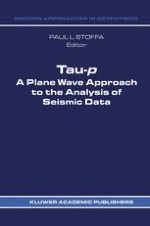1989 | OriginalPaper | Chapter
Plane- Wave Decomposition: A Tool for Deconvolution
Authors : M. Tygel, P. Hubral, F. Wenzel
Published in: Tau-p: a plane wave approach to the analysis of seismic data
Publisher: Springer Netherlands
Included in: Professional Book Archive
Activate our intelligent search to find suitable subject content or patents.
Select sections of text to find matching patents with Artificial Intelligence. powered by
Select sections of text to find additional relevant content using AI-assisted search. powered by
Most (prestack) deconvolution methods for seismic shot records are based on simple stochastic models for the traces. They do not exploit the fact that these traces have to satisfy the wave equation. A plane-wave decomposition of a point-source seismogram recorded over a vertically inhomogeneous layered (acoustic) medium is a process based on the wave equation. It offers the possibility to extract both (a) the causal source pulse of arbitrary unknown shape and (b) the unknown broad-band plane-wave response (reflectivity) for any incidence angle or ray parameter. This was hitherto considered to be impossible but has become a reality if one exploits the wave theory that permits us to compose and decompose point-source responses from vertically inhomogeneous media in terms of plane waves. As starting point for constructing the seismogram by a plane-wave composition serves the Weyl Integral in either its time-harmonic or transient form. The central concept, on the other hand, upon which the plane-wave decomposition is based is the slant stack. The theory of plane-wave composition is briefly reviewed in order to establish the background for the new deconvolution procedure which essentially uses the properties that the reflectivity function (i.e. the reflection response of a layered medium for an incident plane wave) has for above-critical incidence angles.
